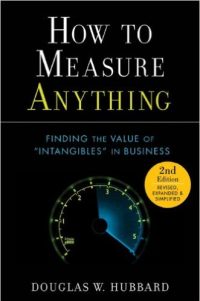Douglas Hubbard certainly knows how to throw down a dare. His book, How to Measure Anything: Finding the Intangibles in Business certainly is a superlative title. The promise is that you’ll be able to measure absolutely anything with the techniques laid out in the book. I have to say that he’s possibly right. Certainly there should be a certain amount of skepticism in any absolute, however, once you understand what measurement is and what is isn’t this makes a lot more sense.
The book starts with some practical examples of measurements that were both simple and very useful. There’s the computation of the circumference of the earth nearly 200 years before the birth of Christ. Then there’s the child who figured out that it wasn’t necessary to measure *how* effective spiritual healers were, it was only necessary to measure *if* they were effective at all. A simple study was able to provide a ton of useful information – much to the display of some now out of work healers.
However, this isn’t where the book stops. It moves on to talk about techniques of monte carlo simulations, fermi estimates, and techniques that can be used to approximate answers in a range. That’s a key point – measurements don’t have to be precise. They need only be accurate. Most folks falsely believe that measurements must be precise – there must be no error in them. However, what Hubbard illuminates is that every measurement has some level of error built into it. We’re far from the hiesenberg uncertainty princple (which says you can’t monitor sub-atomic particles without effecting them.)
Hubbard also talks about estimating and how we have biases that are hard to break in the way that we estimate. As a consultant for my entire career I can tell you that estimating is perhaps the hardest part of the job. Every situation and project is different in some ways and as a result every estimate is a challenge of understanding the impact of the various factors. Hubbard talks about calibrating estimates so that the estimator knows how to estimate better. If you’re a consultant who has to estimate work this part of the book is worth the price of admission.
One of the things I liked most about the book was that Hubbard didn’t get stuck into the statisics and just start talking about numbers and probabilities. While he would tell you that with a random sampling of just 5 items you have a 93.75% change that the mean value for the larger population is in between the largest and smallest sample values. That’s pretty cool. It means that you can check with a really small set of people to get some useful information about the everyone population – presuming your sample is random.
If you have some time to learn more about measurement, you want to check out How to Measure Anything.


No comment yet, add your voice below!